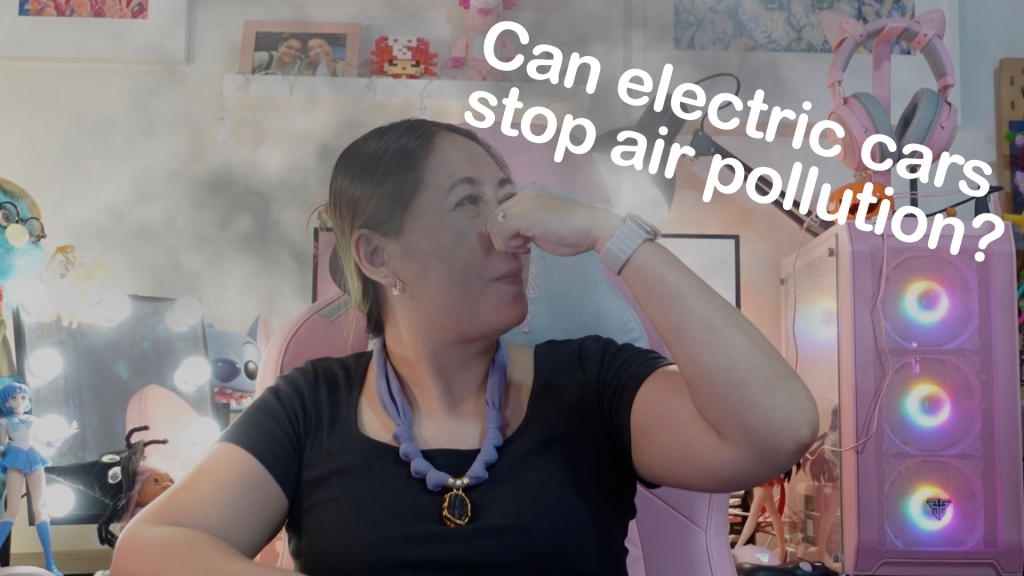Hello Science Fans!
Our air quality has been really bad this past couple of months. We’ve been haunted by the unpleasant smells of smog and vog here in Luzon.
When it comes to the more and more frequent smog and haze formation happening in the cities of the Philippines, pollution from traffic is being blamed. And as a possible solution, the government is now advocating for the transition to electric cars.
Will using electric cars really reduce air pollution? Is this a practical and sustainable solution for the Filipino people?
Find out the answers through our video below, or check out the article we prepared:
But before I answer these questions using science, let me first introduce myself to our new audience.
My name is Chona and I’m your resident Filipina scientist.
I’m a researcher in the field of Molecular Ecology, and it is our goal to find the balance between protecting nature and improving our quality of life.
I’m also a teacher who makes it a point to remind our students that we need to practice empathy when we advocate for the environment.
And SHE-ensya is my science communication channel where I get to share the science behind current events, specially those affected by nature.
So, how does smog form anyway?
Smog formation in large urban areas like Metro Manila is a complex process driven by the interaction of various pollutants and atmospheric conditions. Urban areas are often characterized by high levels of human activity, including the combustion of fossil fuels in vehicles, industrial processes, power plants, and residential heating or cooling. These activities release primary pollutants into the atmosphere, and once in the air, these pollutants undergo chemical reactions, especially when exposed to sunlight and temperature variations. Photochemical reactions, or chemical reactions triggered by light, play a crucial role in forming secondary pollutants, including ground-level ozone (O3), which contributes to the characteristic brownish haze of smog and poses health risks. Metro Manila’s geographical and meteorological factors, such as its topography and climate, can worsen smog by trapping pollutants and hindering their dispersion, especially during periods of stagnant air and sunny weather.
Addressing smog in urban areas requires strict emissions controls, cleaner technologies, improved public transportation, and public awareness efforts to reduce pollution and enhance air quality. Interestingly, car manufacturers have been gradually introducing electric vehicles (EVs) in the Philippines in the hopes of reducing air pollution in the country. In fact, the country has already approved a temporary tariff reduction on EVs and their spare parts to 0%. We even have the EV Industry Development Act (EVIDA) to promote the commercialization of electric vehicles in the Philippines. Some key provisions of this law include the development of charging infrastructure and the local manufacturing of car components. The EVIDA law also mandates that companies and government agencies must include electric vehicles in 5% of their vehicle fleets.
But what exactly are electric cars? Electric vehicles (EVs) are automobiles that utilize an electric motor and a rechargeable battery instead of a conventional gasoline tank. To refuel them, you simply need to plug them into an electrical source, much like charging your laptop or smartphone. One notable advantage of electric vehicles is that they produce zero emissions, making them an environmentally friendly alternative to traditional gas-powered vehicles.
Now, let’s clarify the difference between electric cars and hybrid cars. Hybrid cars and EVs are often confused because both rely on electricity, but they have distinct characteristics. A hybrid vehicle combines a gasoline engine with at least one electric motor. This means the driver can switch between the two power sources or use them simultaneously, depending on speed and driving requirements. Hybrid cars don’t require an external charging point because they charge their own batteries.
But will shifting to EVs really help with our air quality?
Shifting to electric cars can have a positive impact on air quality, but the extent of the improvement depends on several factors.
Electric vehicles (EVs) produce zero tailpipe emissions because they run on electricity stored in batteries. This eliminates the release of harmful pollutants such as nitrogen oxides (NOx), particulate matter (PM), carbon monoxide (CO), and volatile organic compounds (VOCs) that are common with internal combustion engine (ICE) vehicles. As a result, local air quality in urban areas can significantly improve, particularly in places with a high density of vehicles.
Electric vehicles are also quieter than conventional vehicles with internal combustion engines, which can help reduce noise pollution in urban areas. This can have positive effects on public health and well-being.
However, it’s essential to consider some important factors and potential challenges:
The availability and accessibility of charging infrastructure can impact the adoption of electric vehicles. If a gas-powered car runs out of gas, we can just pull over to a nearby gas station and refill. But for TVs, we still need a well-developed charging network with equitable pricing for the recharging. Note also that the efficiency of EVs can vary, so selecting models with better energy efficiency can maximize the environmental benefits.
Sounds great so far, right? But it’s not all clean and green just yet.
The production and disposal of batteries used in EVs can have negative environmental impacts.
The production of lithium-ion batteries, which are commonly used in EVs, involves the extraction of raw materials such as lithium, cobalt, and nickel. Mining and processing these materials can have significant environmental impacts, including habitat destruction, water pollution, and carbon emissions. Manufacturing these batteries is energy-intensive, and the carbon footprint of battery production depends on the energy sources used in manufacturing facilities. In regions where electricity generation relies heavily on fossil fuels, battery production can contribute to greenhouse gas emissions.
Proper disposal and recycling of EV batteries are crucial to reduce environmental harm. Recycling can recover valuable materials and reduce the need for new resource extraction. However, recycling processes can also generate waste and emissions if not managed properly. If batteries are not recycled or disposed of properly, they may end up in landfills, posing environmental risks due to potential leakage of toxic chemicals. EV batteries contain materials like lithium, cobalt, and nickel, which can be toxic if not handled and disposed of correctly. Inappropriate disposal methods can lead to soil and water contamination.
And finally, while EVs do not emit tailpipe pollutants, their overall environmental impact depends on the source of electricity used for charging. In regions with a high percentage of electricity generated from clean and renewable sources like wind, solar, or hydroelectric power, EVs can substantially reduce greenhouse gas emissions compared to traditional gasoline or diesel vehicles.
And in the case of the Philippines, only 20-25% of our energy come from renewable sources. Majority are from coal-fired power plants. These use coal as the primary fuel source to generate steam, which drives turbines to produce electricity, and are known to be some of the highest contributors to air pollution. Natural gas power plants are another significant source of electricity. Natural gas is burned to generate heat, which is then used to produce electricity. It is considered a cleaner-burning fossil fuel compared to coal, but still release a significant amount of pollution.
So at the end of the day, we still need major changes on how we produce energy and on how we manufacture batteries before we see any significant impacts. It can also prevent us from looking at alternative sustainable solutions, such as the improvement of mass transit systems, establishment of safer bike lanes and walk paths, and the consideration of long term work from home arrangements. Of course, a move towards greener technology is always appreciated. It could be the driver to make us use renewable energy. But until then, we can just end up creating a band aid solution that could result to more harm than good.
But what do you think?
Is the Philippines ready for EVs? Do you have recommendations on how we can protect ourselves from smog and haze in the meantime?
Let us know your thoughts in the comments section below.
Thank you so much for dropping by!
If you have any comments, questions or suggestions, please don’t hesitate to contact me, your resident Filipina scientist, in the comments section below.
And remember, when in doubt, always use your (con)science!


One response to “Can Electric Cars Stop the Smog in Our City? | Filipina Scientist Weighs In”
Very interesting
LikeLike